|
 Part 8 – The Mansion  golly gee willickers After their lakeside escapades, the party docks near a cabin and unloads their precious cargo. With Wong safe and sound (Marjorie is borderline catatonic and will be out of commission for the rest of the adventure) they can grill him on what he knows. According to him, Nash was a brilliant researcher who Wong fired for ethics violations and he swore revenge on him in classic mad scientist fashion before disappearing. Wong can’t tell the party what Nash did to get fired (nondisclosure agreements) or how Nash might be controlling the townsfolk (he knows but isn’t telling), though. While he refuses to budge from his position, he’ll hang out in the cabin for the rest of the adventure and dispense information and advice. Next up: finding Nash. Link points the GM towards the old mine (situated in the laughably on-the-nose Mt. Baldy), but the party can still go back into Black Lake to sniff around for more clues. They find things largely the same but with a twist; occasionally someone will mention Nash in a conversation and it will grind to a halt, followed by everyone in earshot chanting his name (the PCs have to play along or they’ll get hauled off to jail). Everyone now reveres Nash (and someone who might be his mother, though she is less of a focus) and views him as something between a father figure and a savior. Psionic or magical investigations reveal this reverence to have been artificially implanted in their heads (no poo poo, Link) and it can be removed with psionics. If the attempt fails, they turn them into a vegetable.  Even if they were involved in the firefight, the PCs will be largely ignored. However, they are looking for Wong still (unless they caught him back at the mansion, in which case patrols still roam the streets) and unfortunate questions will get the party hauled off to jail. Spend too much time in there, and the black van will come for you! The townsfolk also don’t have anything interesting to say, so why bother. I like imagining questions the PCs ask the townsfolk involving Nash, no matter how they are phrased, ending with them chanting “Nash! Nash! Nash! Nash!” Sounds like a great way to annoy your players. Even if they were involved in the firefight, the PCs will be largely ignored. However, they are looking for Wong still (unless they caught him back at the mansion, in which case patrols still roam the streets) and unfortunate questions will get the party hauled off to jail. Spend too much time in there, and the black van will come for you! The townsfolk also don’t have anything interesting to say, so why bother. I like imagining questions the PCs ask the townsfolk involving Nash, no matter how they are phrased, ending with them chanting “Nash! Nash! Nash! Nash!” Sounds like a great way to annoy your players.  So when the PCs actually reach Mount Baldy they find an old mine built into the cliff face. It looks like it’s been left untouched since the mine close except for tracks leading into and out of the mine, some trailers off to the side, and locks on the front gate. Also, the guard post built under the water tower. There’s a guard there that will try and warn off interlopers, only using force when words fail (and even then pausing to tell them to get out every so often); he’ll also call the cops, who will drag the PCs off to jail to wait for the black van to swing by and do its magic on them. There are a couple of ways into the mine involving breaking open doors, picking locks, etc. – your standard infiltrating-the-base shtick, you’ve seen it before. There’s even an air duct system for the PCs to crawl through! This part of the book is mostly map descriptions, ways to get through the mine, and mechanics; I’ll just brush over these for the most part, only remarking on unusual features. The mine’s first level is dominated by a garage which contains the black van we’ve been seeing around town and a few motorcycles, including one modified for a little person. The party can also find a pit full of zombies in a nearby tunnel. Finally! On seeing the party will try to attack them but they can’t climb up the sides of the pit. It blocks off the way further into the mine and the PCs will have to find a way across (laydown planks, roll to balance), as well as spot an intercom and give “the password”. What password? I don’t know! If you don’t give the password, the mine’s primary protectors will mobilize from the floor below. Beyond lies a series of prison cells that contain the real Julie Goldblum as well as Capt. Fred to serve as extra muscle for the party (when was he captured? Am I missing something?), and beyond that lies the way down to the next floor. Next time: The Thrilling Conclusion
|
|
|
|

|
| # ¿ May 10, 2024 19:27 |
|
Midjack posted:Mt. Baldy in California is the location of a Zen monastery. Leonard Cohen spent some time there in the 90s. Huh. There's no mention of a monastery in the book. The town has a Buddhism-inspired cult, though. Is there a Black Lake-equivalent nearby?  Part 9 – CONCLUSION 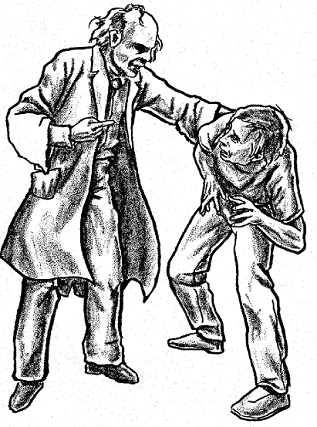 Now, my son, you ought to go apologize to your sister for killing and cloning her. It’s what God would have wanted. At some point as the party reaches the bottom of the mine, they encounter Nash’s mercenary squad, the Four Horsemen. They are loyal to money before Nash and can be convinced to leave if paid off or if they face overwhelming firepower; they are still pretty tough, though. They might also encounter Fidel, Nash’s stereotypical underling, a hunchback who reveres him and tries to carry out his bidding without question, but he’s incompetent and entrusted with too much control over the hideout’s defense systems for him to handle. He’ll be hard to manipulate but easy to intimidate. After a bit more wandering the party will finally hit paydirt; the three chambers Nash uses for his diabolical plots. In one they can find massive test tubes for creating zombies, including one currently gestating in the same green goo Julie exploded into earlier; the second contains cloning tubes and computers with the scientific data necessary to make more (clones of Capt. Fred and Julie take up two of them, but if the party tries to decant them the clones will fall out, writhe mindlessly, and die, provoking an extreme Fright Check); and the third has computers containing extensive profiles of every resident of Black Lake, complex enough to re-create every citizen of the town with their prior personalities restored. If these computers are somehow destroyed or damaged, some profiles will be deleted or corrupted and that citizen will be effectively dead. Well done! Once Nash is dead the party can use them to bring the townsfolk back to life and replace the clones. At this point Link tells us the party should have enough information to reconstruct Nash’s history and motivations. Like Wong said, Ezra Nash was a brilliant but unethical scientist who got fired for performing really gross experiments on his own time. This pushed him off the deep end and he went to ground, eventually getting picked up by the Cabal (GURPS’s evil magical conspiracy, mentioned earlier) as a resident mad scientist. With their help Nash perfected a way to create digital copies of people’s minds, modifying them, and inserting them into clone bodies – he made Fidel as his first test subject – then headed to Black Lake to prepare his vengeance against Wong. His plan went like this: first, enter town with an identity and credentials (“Bob Smith”) provided by Cabal shell companies; persuade Doc Basset to “test out” his mind-scanning machine, get his information, clone him, and kill him and dump his body; have the clone run the rest of town through the machine, clone them, and kill the originals; threaten Wong anonymously until he fled to his retreat near Black Lake; and finally lead the clones against the mansion and kill his former employer. The plan was just kicking into action when the PCs arrive, hence the signal jamming. Also, Autoduel information. Been a while! Basically, Future Nash did those experiments with pre-existing cloning tech at Columbus before Wong noticed his clones were implanted with memories he’d constructed and had him fired. That’s it!  Finally, an opportunity for a REAL Thriller joke! By the way? The zombies? Nash just made them as a distraction for investigators and/or observant townsfolk. This adventure is actually about clones. Holy false advertising, Batman! The book provides schedules for Nash, Fidel, and the Horsemen, as well as the former’s plans for dealing with interlopers (spot them, sic the horsemen on them, arm himself and Fidel if they fail, call town for a posse of a dozen or so to come back them up, and hold the party off until help arrives). Link doesn’t tell us what Nash will do if they happen to catch him, but implies they’ll have to kill him; otherwise he’ll either escape through a hidden tunnel, escape AND join up with the clone posse to ambush the PCs, or capture them and kill them. Once he is dead or gone, the adventure is effectively over. Forgot to mention: Nash implanted reverence for his mother in every clone. Because of COURSE he wasn’t evil enough without Oedipal themes. Somehow the clones in town will detect Nash’s death and immediately fall into confusion, some committing suicide out of despair. From there the book suggests reconstructing the townsfolk from Nash’s database – no Star Trek transporter problem here! – and try and integrate surviving clones into the community. Two days later the authorities arrive, grill the PCs as they try to sort out what happened, and eventually let them go. The party completed the adventure! Yaaaaay! The last few pages of the book cover various reasons the party might return to Black Lake – just adventure hooks with little interesting about them so I don’t care about writing them up. FINAL THOUGHTS  That was… interesting. This book smacks of someone trying to work in every part of GURPS they liked into one rickety adventure. There’s just too many connections to thematically conflicting settings and a lack of focus in general. Why the hell does this book contain Autoduel rules? They don’t add anything, they don’t connect to anything outside the town, and they clash with the fearful atmosphere the book tries to set up. To be fair, it remarks up front that the adventure is designed to break Autoduel characters out of their comfort zone, but why focus on that setting specifically? It clashes too much with the run-and-gun style you’d expect from it for the adventure to serve as a breather episode. The mechanics are clunky, the characters are broad sketches or stereotypes, and the story is clichéd. It’s not that it’s awful, per se, it’s just not great. I can see why Link never wrote another adventure. But, whatever. It only cost me a few bucks, so it’s not like I regret buying it. I wouldn’t run it myself but I can see others running it for whatever reason. Inklesspen, whenever you have time to next update the archive, I expect to see all THREE of my reviews marked as completed
|
|
|
|
|
|
|
|
What are two great tastes that taste great together? I don’t know either. You get this instead. Introduction and  In 1995, Chaosium licensed Call of Cthulhu out to Steve Jackson Games for use in their own GURPS game line. But not for a direct adaptation, no; got to avoid direct competition, you understand. Instead they decided to mash it up with Cyberworld, GURPS’s pet cyberpunk setting, for reasons that remain blessedly obscured to mortals. After conducting foul ceremonies culminating in the ritual sacrifice of a Wizards of the Coast employee, probably, they summoned another GURPS awkward marriage like Zombieland, USA – except this one seems quite a bit better put together. Let’s take a look, shall we? “the first two lines of GURPS Cthulhupunk” posted:CthulhuPunk. The Cthulhu Mythos meets cyberpunk. At first glance, it might seem an unlikely combination. Yeah, book, no foolin’. The author’s reasoning goes like this: fiction about both the 20s and 30s and about cyberpunk both feature impoverished and oppressed masses, flashy and dramatic criminals, revolutionary new technology, and creeping, authoritarian power structures. When you throw Lovecraft in to that first category, both genres deal with fundamentally hopeless worlds where the efforts of the individual don’t truly matter and where incomprehensible, distant forces shape their lives with or without their knowledge. Protagonists can’t hope to overturn those forces (and usually don’t even try), but they can fight those forces and win; after all, even Lovecraft had Ol’ Squidly himself meet his (temporary) end at the hands of a motorboat, and the Treasury Department disappear Innsmouth’s population and dynamite the Deep Ones’ reef off the coast. That, then, is where the PCs figure in: while complete victory is beyond them, they can go up against local threats and take them down, keeping themselves and the people around them alive a short while longer. Fair enough, let’s see how the premise holds up. 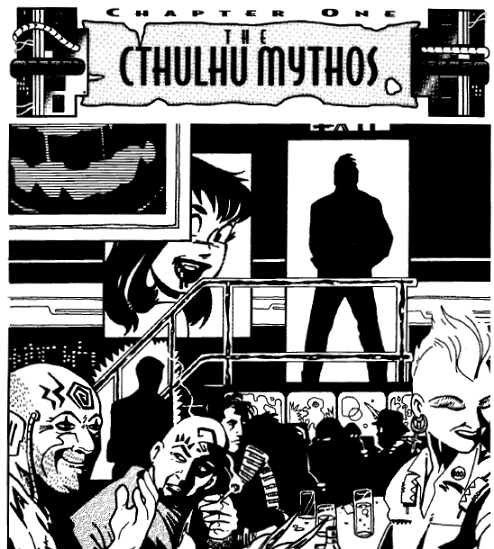 Hey, it’s Vampironica! The art in this thing is amazing – real gonzo, lots of blood and tentacles and cybernetic bits, appropriate stuff to the setting. The layout, on the other hand… ehh, it’s fine. It combines the standard GURPS Third Edition main-column-and-sidebars I’ve run into elsewhere with the occasional unexpected lurch into a two-main-column format; a bit confusing, but I’ve seen worse. As for the typography, it’s pretty obvious they scanned the book with word recognition software when converting it to a PDF; the text seems to switch font every few words and creative misspellings pop up wherever the software got confused (either that or they call the continent flfrica). I mean, praise the Gate, Key, and Guardian that I can copy and paste text from it, but it sure looks hilarious. I feel bad about taking points off for this one, given it’s a mechanical error rather than a mistake on the part of the writer, so I won’t. Instead, I’ll list my favorite misspelling from that section at the end of each part of this review. See if you can tell what each one used to be! There’s the legally-required short story at the start of each chapter to introduce you to the setting, but… 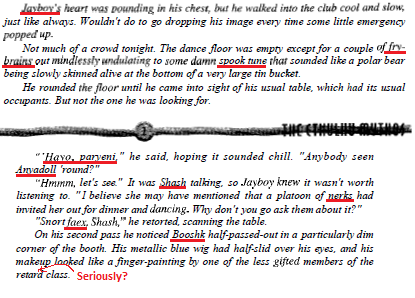 Yeah, no. The first chapter covers the Cthulhu Mythos in general in a brief 20 pages. I’m going to go out on a limb and assume you know the general outline, so I’ll gloss over most of this. After explaining the existential horror that underlies the whole thing, the author lists out notable gods, grimoires, locations, and artifacts, blazing through its history as a concept and advice for GMs trying to role-play incomprehensible ancient monstrosities before culminating in a timeline that links everything together. By far the most interesting part of the chapter lies in the last set of sidebars, which examines how and why this stuff could’ve slipped under the radar past modern information technology and remained secret – and it appears to have been written in isolation from the next chapter. 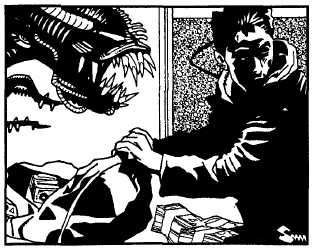 World-class home defense technology. Let’s take it from the top. Provided information is in normal font, later setting information is in italics.
I get the feeling the author stole most of this chapter from CoC’s setting bible and reworded it for public consumption. Oh well, it gets the job done. As an aside, I just realized: most surviving copies of ancient, forbidden texts in Cthulhuoid settings were printed, not hand written – not just here, but in general. Can you imagine? Taking a look at a book about summoning demons from beyond the stars and deciding, "I'm gonna sell this on the mass-market!" 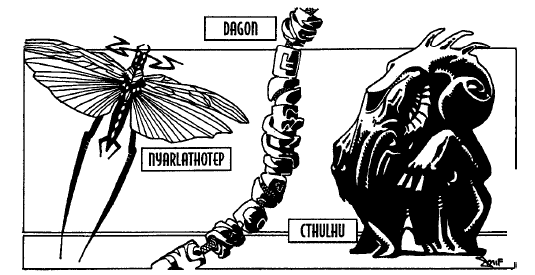 A picture of idols/worship aids for various cults. I like it, gives a visual reference point for GMs and players Typo of the Day: hov e ; Next Time: Cyberworld setting information; you can fit an entire color magazine into 500 kB.
|
|
|
|
So, uh, let's talk about another setting involving imperialism! World 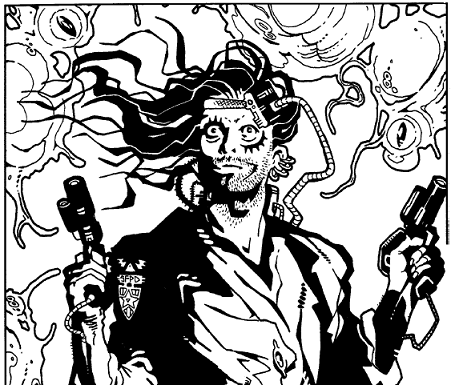 That wasn’t weed. Setting information! I lied last time, I decided to go through this section setting-technology-culture, all of which are packed together in one fat chapter. Apparently this section just restates stuff from the Cyberworld sourcebook with an emphasis on how it might interact with the Mythos. Given just how much setting information it dumps on you, that sourcebook must be absolutely titanic.  I didn’t enjoy 2017 much either, but it wasn’t THAT bad. The current year is 2040… something, I couldn’t find an exact date. Cyberworld sure wasn’t shy about kicking its alternate history off; the first event listed in the timeline this book provides (Boris Yeltsin’s assassination) happened one year after this book was published, and the two big factors that shaped Cyberworld should have come and gone by now. The first was a superbug called Tolliver’s Disease (and several nicknames, including my favorite, “the Toller”) that killed over 1 billion people and caused societal collapse in many parts of the world. While first world nations were able to get access to the cure pretty quick once it came out, but much of the Third World couldn’t get their hands on it fast enough to keep their governments from collapsing – meaning we’re back to Darkest Africa (and India) again …the Grand Slam. Amazing. 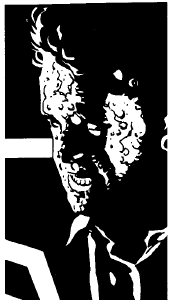 “The Toller” can leave scars so severe they affect your Attractiveness rating. Geopolitics! The US is firmly in decline, superseded by rising powers elsewhere. After both political parties exploded around the turn of the millennium, an archconservative named Patterson came to power in the wake of his predecessor’s assassination (possibly at his own hand). Patterson blamed it on an “Army of Satanic Order” he probably made up and basically started up the Satanic Panic again. After a few decades the US government’s decayed into a pseudo-theocratic dictatorship under his successor, a former secret police administrator named Hammond. It’s pretty standard dystopian stuff; everyone has a citizenship status, censorship is universal, the secret police has a god-awful nickname, etc. For some reason the US diplomatically annexed both the bulk of Mexico and Cuba, though the latter is going through yet another revolution right now; while now US citizens in theory, they are effectively second-class citizens because, you know, neocons. Canada has broken into independent parts, while Alaska keeps its distance from the central government and remains actually democratic. What about Central America and the Caribbean? What about Central America and the Caribbean? In South America, Brazil’s been turned into a giant nature preserve by the Russo-Japanese (more on them in a bit) and most other countries are relatively prosperous but struggling with massive drug cartels growing cyber-cocaine and techno-heroin. The big exception is Chile and Argentina, which now, unified as – wait for it – Chiletina, position themselves as the world’s fastest growing economy and “the upstart of the 21st-century international scene”. If it’s cutting-edge and not from the Russo-Japanese, it’s from them. If it’s not from either of those two, it comes from somewhere else in the Pacific Rim; any of the Asian Tigers, Southeast Asia, the Philippines, etc., all of which are growing and prosperous. Singapore is both the region’s unofficial capital and the center of its black market. The book doesn’t even mention Indonesia  . Sorry guys. . Sorry guys.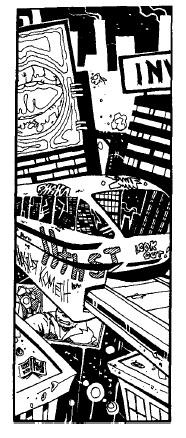 Disneyland’s doing better these days. Europe’s done pretty well for itself – it’s formed 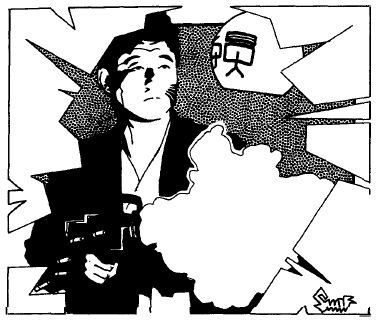 How jaded do you have to be to look that bored firing a submachine gun? But as much as the US, Europe, Chiletina, and various other powers around the world might try, they can’t compare to the Russo-Japanese Economic Union. Originating in an agreement between the CIS and Japan that was supposed to relieve the economic troubles and disorder of the former and of the overpopulation (hah!) and resource shortages of the second, it’s morphed into the planet’s economic, industrial, and even cultural center. Like, a good half the setting's most powerful corporations have Russian or Japanese names. Of course, there’s a brewing power struggle between the wealthier Japanese part and the resentful rest of the Union, but that has yet to boil over. Australia just kind of… got depopulated. Everyone on the Australian mainland got killed by a mysterious disease in just six months a few ways back, so the island’s been quarantined for the next few decades just in case (its neighbors and Tasmania are just fine). Best guess to what happened is a Chinese bioweapon gone off prematurely, but no one knows for sure. Right now, anyone who heads into the Outback (mostly disposables sent in in secret by various powers) disappears after about a week, but satellites still pick up some low-tech activity deep in the interior. Can you say “Mythos activity”? I can’t! Speaking of which… oh boy, it’s time to cover Africa, India, and China. 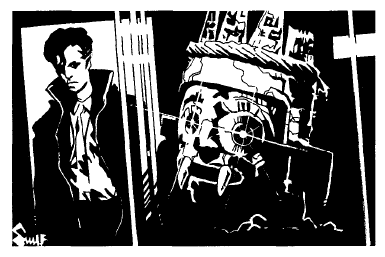 We’re covering THIS now. I’ll cover the book’s approach to issues of race and Lovecraft (and its successes and failures) in detail when it comes up later on, but it boils down to this: if one postulates a universe full of forces completely beyond humanity’s power to grasp or struggle with, the artificial definitions of race and culture look ridiculous. Lovecraft was so obsessed with race () he had an identity crisis when he discovered he might be part Irish; his concept of racial hierarchies ran so deep he felt he had to organize the universe along those lines. The author believes that undermines the point. A fear of incomprehensible outside forces runs through all of us, so portraying those forces as inherently unknowable foils any attempts to come to terms with and control them – a solid basis for a horror story. Sorting humans by appearance categories defeats the point. Racism is so mundane and social that, for anyone who isn’t Lovecraft or thinks like him, it just dilutes the cosmic horror and makes it look petty. Instead, the author chose to mix cosmic horror with cyberpunk, a genre also characterized by incomprehensible forces crushing people, but one where Lovecraft’s perfect Anglo-Saxon society has collapsed under its own rotten bulk and cultures from other parts of the world are calmly taking its place. It flips that script – societal change shaped by impersonal economic and cultural forces becomes another aspect of an incomprehensible universe. If so, no section of humanity is inherently better or worse than another; all of us are attempting to survive in a reality that barely acknowledges the differences between us before it runs us over. And then they pull poo poo like this. It isn’t that the author brings up racist themes when covering Africa, India, and China; he barely brings up anything. The description of India and Africa essentially reads ‘screwed over by the Grand Slam and not visited much’, while China just shut itself off from the outside world a couple decades back and nobody knows what’s going on inside there. But it’s no accident that the author declares the African continent and Indian subcontinent disorganized and, well, he actually describes those regions as being without civilization. Sound familiar? He’s just returned he extremely complex and sophisticated peoples and cultures to a uniform low so your characters can head out and be scared of natives in the jungle. And China? It’s no mistake that he’s had China seal itself off from the outside world. It neatly invokes Qing isolationism and the way Communist China sealed its borders to create The Mysterious East once again, ripe for GMs to insert Orientalist themes theoretically debunked the better part of a century ago. And let’s not forget, the non-Anglo-Saxon cultures that are rising to fill the gap? A union of two former colonial powers and one of the successors to another. You can’t do this in half measures, guy. I really do believe there’s something to be said for cosmic horror and that this book has entertainment value, but you gotta untangle it from its roots first. Half-assing it doesn’t do anybody any favors. 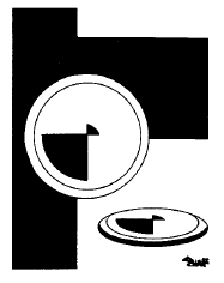 Have a picture including no human beings. Typo of the Day: Rurro-Japanere Next Time: how can most members of a culture that spends all day on the Internet be only semiliterate?
|
|
|
|

|
| # ¿ May 10, 2024 19:27 |
|
Zhuge Liang, gone back in time 200 years to prevent the fall of the Han Dynasty.
|
|
|




 here]. On the other hand, a few subcultures do know a bit about Mythos stuff, enough for a fake Necronomicon to make the rounds on shadier parts of the web.
here]. On the other hand, a few subcultures do know a bit about Mythos stuff, enough for a fake Necronomicon to make the rounds on shadier parts of the web.